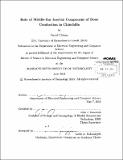Role of middle-ear inertial component of bone conduction in chinchilla
Author(s)
Chhan, David
DownloadFull printable version (5.544Mb)
Other Contributors
Massachusetts Institute of Technology. Department of Electrical Engineering and Computer Science.
Advisor
John J. Rosowski.
Terms of use
Metadata
Show full item recordAbstract
Bone conduction describes the mechanisms that produce a hearing sensation when the skull bones are subjected to vibration. Multiple components and pathways have been suggested to contribute to total bone-conducted sound. They include outer-ear cartilaginous wall compression, middle-ear inertia, fluid inertia, cochlear capsule compression and soft-tissue conduction. Due to the complexity of the possible interactions within these components and pathways, the true stimulus to the inner ear is not fully understood nor has it been adequately quantified. In this thesis work, we examined the relationship between inner-ear sound pressures and its sensory response in addition to determining the relative significance between the outer, middle and inner ear mechanisms that are prominent in bone conduction hearing in chinchilla. Using both mechanical and physiological recording techniques, we measured cochlear responses in chinchilla before and after interruption of the middle-ear ossicular system in both air conduction (AC) and bone conduction (BC) stimulation. Our data suggest that differential intracochlear sound pressure is the driving source to the sensory response of the inner ear in AC and BC. Compared to those in AC, inner-ear sound pressure measurements in BC provide evidence of multiple mechanisms in BC process. After middle ear interruption, pressures in scala vestibuli Psv and scala tympani PST drop by as much as 40 dB in AC, but only decrease in Psv by 10 dB, with almost no change in PST in BC. The difference in the change of both Psv and PST in BC compared to AC suggest the main mechanisms that drive the inner ear response in BC are not derived from the outer ear or middle ear but the inner ear.
Description
Thesis (S.M.)--Massachusetts Institute of Technology, Dept. of Electrical Engineering and Computer Science, 2013. Cataloged from PDF version of thesis. Includes bibliographical references (p. 53-55).
Date issued
2013Department
Massachusetts Institute of Technology. Department of Electrical Engineering and Computer SciencePublisher
Massachusetts Institute of Technology
Keywords
Electrical Engineering and Computer Science.